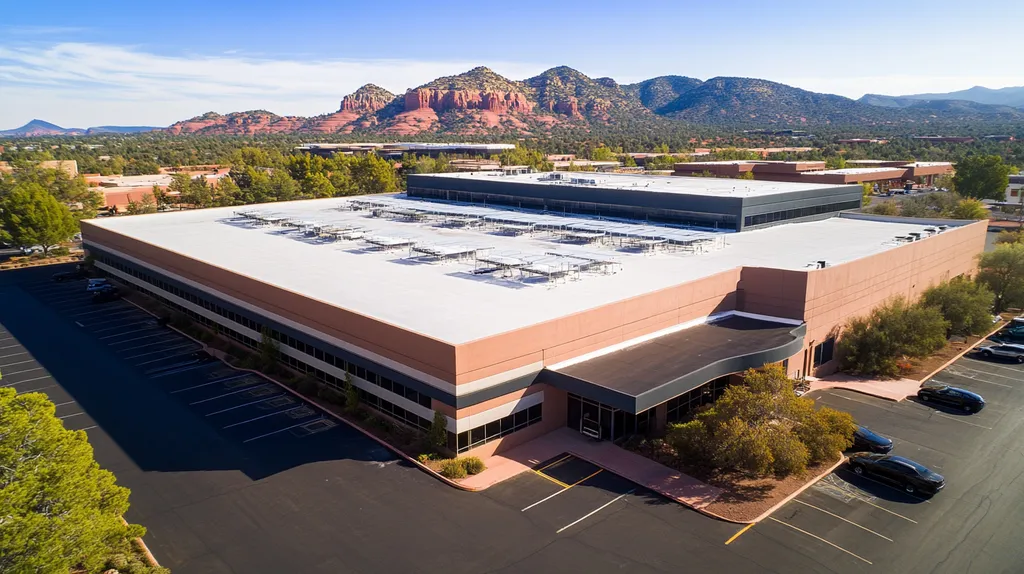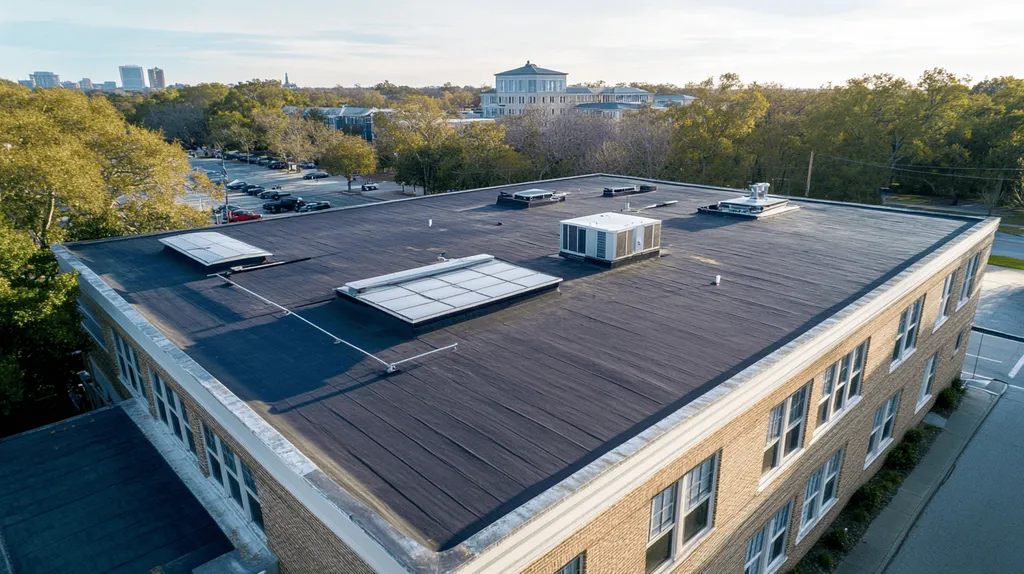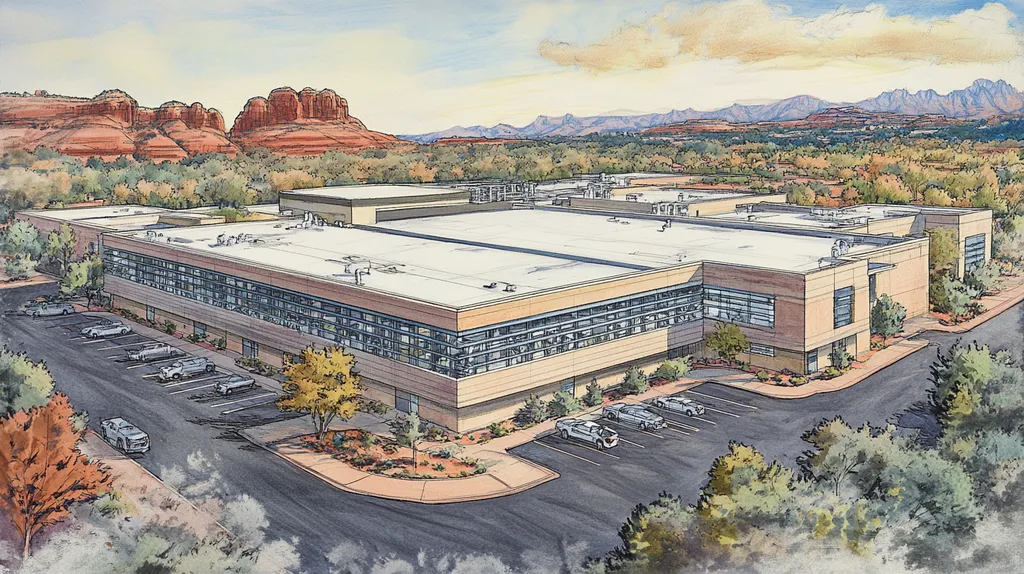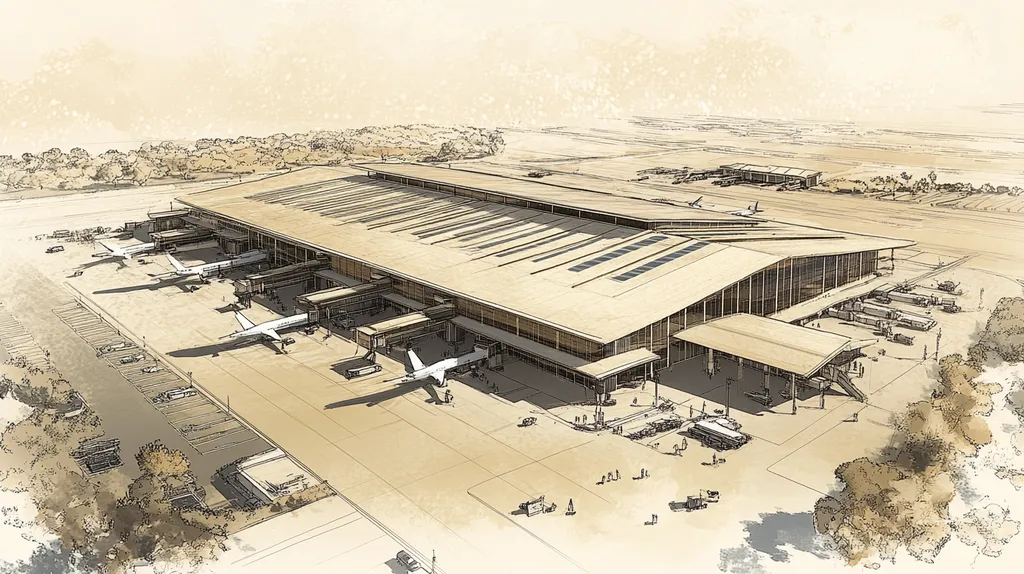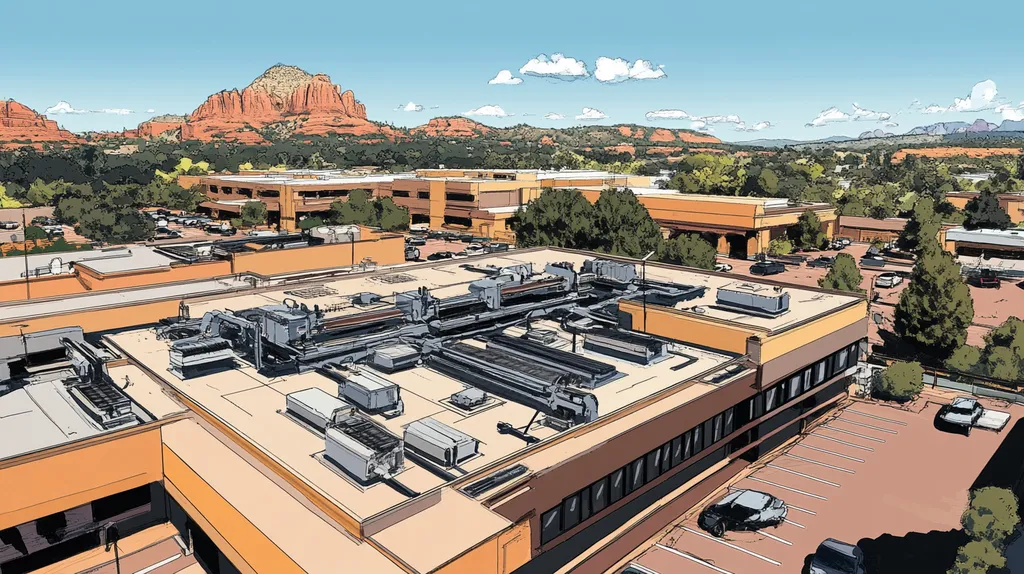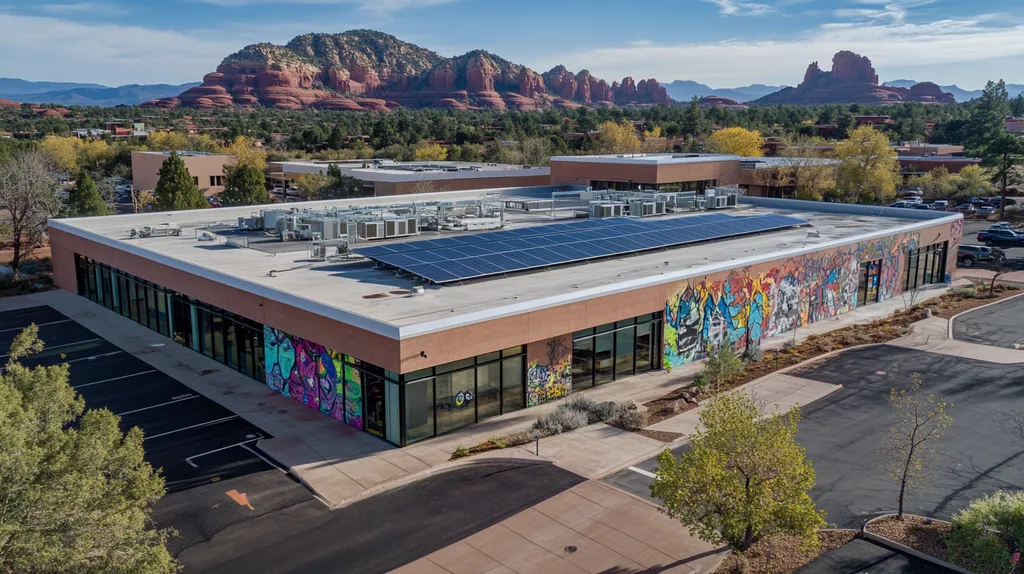In an era where 76% of commercial properties struggle with aging, unattractive roofs, the intersection of aesthetics and functionality has become critical for property value and tenant retention.
The appearance of commercial roofing directly impacts lease rates, energy efficiency, and brand perception, yet most facility managers focus solely on basic maintenance while overlooking crucial enhancement opportunities.
This comprehensive guide examines proven strategies for transforming commercial roofs from mere protective barriers into valuable architectural assets that deliver measurable returns on investment through enhanced aesthetics, improved performance, and strategic system integration.
SECTION 1: FUNDAMENTAL CONCEPTS
In today’s competitive commercial landscape, a building’s roof does more than just protect—it communicates value and professionalism. While 82% of facility managers focus solely on roof functionality, they’re missing a crucial opportunity to enhance property value and tenant satisfaction through thoughtful aesthetics. Understanding the interplay between visual appeal, performance, and brand identity has become essential for property owners seeking to maximize their building’s potential.
Understanding Roofing Aesthetics
Commercial roof aesthetics encompass three key elements: visual impact, architectural harmony, and perceived quality. A well-designed roof can transform a mundane building into a landmark property, directly influencing tenant retention and rental rates.
Color selection plays a pivotal role in roof aesthetics, with modern coating systems offering unprecedented flexibility. The right color choice can complement corporate branding, reduce visual mass, or help the building blend seamlessly with its surroundings.
Texture and pattern variations create visual interest and can mask mechanical equipment or other rooftop utilities. Strategic use of different roofing materials can break up large expanses and create intentional focal points.
Material selection impacts both appearance and perception. Premium materials like architectural metal or designer membrane systems signal quality and innovation, while sustainable options like garden roofs demonstrate environmental responsibility.
Balancing Form and Function
Effective commercial roofing must strike a delicate balance between aesthetic appeal and performance requirements. This balance starts with understanding local climate conditions, building codes, and operational needs.
Material selection should prioritize durability while achieving desired visual effects. Modern roofing systems offer innovative solutions that combine attractive finishes with superior weather resistance and energy efficiency.
Design elements must account for practical considerations like drainage patterns, equipment access, and maintenance requirements. Even the most attractive roof will fail if it can’t perform its core protective functions.
Integration of mechanical systems and safety features requires careful planning to maintain aesthetic appeal. Screening systems, walkway paths, and access points should be incorporated thoughtfully into the overall design.
Role of Roof Design in Branding
A commercial roof serves as a powerful canvas for brand expression. From aerial visibility to street-level impact, roof design can reinforce corporate identity and create memorable impressions.
Strategic use of corporate colors, logos, and architectural elements can transform roofs into brand assets. This is particularly valuable for retail locations, hospitals, and corporate campuses where brand recognition drives value.
Distinctive roof designs create visual landmarks that aid in navigation and memory retention. Properties with recognizable rooflines often become reference points in their communities, enhancing their market position.
Modern design techniques allow for creative expression while maintaining functionality. Features like illuminated elements, green spaces, and geometric patterns can create signature looks that differentiate properties in crowded markets.
SECTION 2: SYSTEM COMPONENTS
Modern commercial roofing has evolved far beyond basic weather protection. Today’s integrated systems can transform a property’s aesthetics while delivering measurable performance benefits. Statistics show properties with enhanced roofing systems command 5-15% higher lease rates and significantly reduced operating costs. Understanding the strategic deployment of key system components allows facility managers to maximize both visual appeal and functional value.
Green Roofs and Vegetation
Green roof installations represent a revolutionary shift in commercial roofing aesthetics. These living systems transform barren rooftops into vibrant, sustainable landscapes that create immediate visual impact and environmental benefits.
Strategic vegetation placement can mask mechanical equipment while creating dynamic seasonal color changes. Native plant selections ensure year-round visual interest while minimizing maintenance requirements.
Beyond aesthetics, green roof systems provide substantial thermal benefits. The natural insulation reduces heating and cooling costs while extending roof membrane life through temperature stabilization.
Modular green roof designs allow for phased installation and easier maintenance access. This flexibility enables property managers to expand vegetated areas as budgets allow while maintaining critical roof access.
Solar and Energy-Efficient Systems
Modern solar installations have evolved beyond purely functional arrays into architectural design elements. New mounting systems and panel configurations can enhance building lines while generating clean energy.
Strategic panel placement creates visual rhythm across large roof areas. This transforms necessary equipment into an intentional design feature that communicates environmental leadership.
Integrated solar solutions combine seamlessly with other roofing components. This coordination ensures optimal performance while maintaining clean sight lines and professional aesthetics.
Solar canopies and carports extend renewable benefits while creating architectural interest. These dual-purpose structures add valuable covered spaces while reinforcing sustainability commitments.
Advanced Membrane Materials
Today’s high-performance membranes offer unprecedented aesthetic flexibility while delivering superior protection. Modified bitumen systems with decorative finishes create stylish surfaces that enhance energy efficiency through improved solar reflectance.
PVC and TPO membranes now come in an expanded palette of colors and textures. This variety allows facilities to coordinate roofing with corporate branding while maintaining durability.
Hybrid systems combining multiple materials create custom aesthetic solutions. These engineered assemblies deliver targeted performance benefits while achieving specific design objectives.
Advanced coating systems protect membrane appearance while extending service life. Regular maintenance of these finishes ensures lasting visual appeal and optimal performance. (source: United Seattle)
SECTION 3: IMPLEMENTATION METHODS
Commercial roof aesthetics directly impact property value, tenant satisfaction, and operational costs. Studies show that aesthetically enhanced roofs can increase property values by 8-12% while reducing energy costs up to 35%. However, achieving these benefits requires careful implementation that balances visual appeal with system performance and longevity.
Designing for Climate Resilience
Climate-resilient roof design begins with thorough analysis of local weather patterns and environmental stressors. This assessment shapes material choices, drainage systems, and protective measures that maintain aesthetic appeal under challenging conditions.
Strategic slope design and drainage pathways prevent water accumulation while creating visual movement across the roof surface. These intentional contours can transform functional necessities into architectural features.
Temperature fluctuations demand materials that resist thermal stress without compromising appearance. Modern solutions like cool roof coatings maintain their aesthetic appeal while reflecting harmful UV rays.
Wind uplift protection requires careful attention to edge details and mechanical attachments. These critical components can be integrated into attractive fascia systems that enhance the building’s profile.
Selecting Materials for Durability
Material selection must prioritize long-term performance while achieving desired aesthetic goals. Roofing material selection, structural integrity, and energy efficiency work together to create lasting visual appeal.
Metal roofing systems offer exceptional durability while providing clean, modern aesthetics. Their versatility allows for creative expression through color, pattern, and texture variations.
Advanced membrane systems combine superior weather resistance with design flexibility. These materials maintain their appearance through decades of exposure while offering unprecedented color options.
Protective coatings and finishes extend material lifespans while preserving aesthetic qualities. Regular maintenance of these surfaces ensures consistent appearance and performance throughout the roof’s service life. (source: Samsite Roofing Systems)
Installing Hybrid Roofing Systems
Hybrid systems combine multiple roofing technologies to achieve optimal performance and aesthetics. These integrated solutions allow designers to maximize visual impact while meeting complex performance requirements.
Careful material transitions create opportunities for distinctive design elements. Strategic use of different surfaces can break up large expanses and create intentional focal points.
Installation sequencing ensures proper integration of system components. Each layer must contribute to both the visual composition and the overall system performance.
Quality control during installation preserves both aesthetics and functionality. Precise detailing at transitions and penetrations maintains system integrity while achieving clean, professional appearances.
SECTION 4: MAINTENANCE REQUIREMENTS
Maintaining commercial roof aesthetics requires a strategic balance of preservation and enhancement. Industry data shows that proactive maintenance programs can extend roof life by 50% while preserving visual appeal. Yet many facility managers wait until visible deterioration occurs, leading to accelerated aging and compromised appearances. Understanding essential maintenance practices helps protect both the aesthetic investment and structural integrity of commercial roofing systems.
Regular Inspection Practices
Systematic roof inspections form the foundation of aesthetic preservation. Professional evaluations should occur at minimum twice annually, with additional checks following severe weather events or mechanical system modifications.
Documentation through detailed photography and condition mapping helps track aesthetic changes over time. This visual record enables facility managers to identify developing issues before they impact appearance.
Inspection timing should align with seasonal challenges that affect roof appearance. Spring evaluations catch winter damage, while fall inspections prepare roofing systems for harsh weather ahead.
Modern inspection tools like infrared scanning can detect hidden moisture that threatens both performance and aesthetics. Early detection through technology-assisted inspections prevents extensive surface damage.
Preventive Repair Strategies
Proactive repairs maintain aesthetic integrity while preventing escalation of minor issues. Small surface defects should be addressed within 30 days to prevent spreading and visual deterioration.
Material transitions and flashings require particular attention during maintenance. These high-stress areas often show the first signs of aesthetic decline and need regular reinforcement.
Debris removal and surface cleaning preserve reflectivity and appearance. Regular washing prevents biological growth and staining that can permanently mar roof surfaces.
Strategic repair scheduling helps maintain consistent appearance across large roof areas. Coordinating repairs by section prevents patchy appearances while optimizing crew efficiency.
Coating and Refurbishment Techniques
Balancing anatomy and aesthetics in commercial roofing requires careful attention to coating selection and application timing. Modern coating systems can dramatically enhance appearance while extending service life and improving energy efficiency.
Surface preparation significantly impacts coating performance and final appearance. Proper cleaning and primer application ensure uniform coverage and lasting visual appeal.
Coating compatibility with existing materials demands careful evaluation. The wrong combination can lead to adhesion failures that compromise both protection and aesthetics.
Regular recoating intervals maintain consistent appearance and protection. Professional application techniques ensure smooth, attractive finishes that enhance building value. (source: PHP SD)
SECTION 5: PERFORMANCE METRICS
Modern commercial roofing demands rigorous performance tracking to protect aesthetic investments and maximize property value. While 73% of building owners focus solely on visual appeal, the true measure of roofing success lies in measurable metrics that affect both appearance and function. Understanding and tracking these key performance indicators helps facility managers make data-driven decisions that enhance both beauty and longevity.
Energy Efficiency Assessment
Cool roofs represent a cornerstone of modern roofing efficiency, reflecting up to 80% more sunlight than traditional surfaces while dramatically reducing cooling costs. These reflective systems maintain their aesthetic appeal longer by minimizing thermal stress and UV damage.
Smart monitoring systems now allow real-time tracking of roof surface temperatures and thermal performance. This data helps facility managers optimize energy efficiency while protecting decorative finishes and coatings.
Thermal imaging and moisture mapping provide detailed performance insights that guide maintenance decisions. Regular assessments can identify efficiency losses before they impact both energy costs and visual appearance.
Advanced roofing materials combine superior insulation with attractive finishes that maintain their appearance. Cool roof technologies reduce heat absorption while presenting a clean, professional appearance that enhances property value.
Water Management and Drainage
Proper drainage design prevents ponding water that can stain and deteriorate roofing materials. Strategic placement of drains and scuppers maintains aesthetic appeal while ensuring rapid water removal.
Flow monitoring systems track drainage performance and identify potential blockages before they cause visible damage. This proactive approach preserves surface appearances while protecting underlying materials.
Integrated drainage paths can enhance visual appeal through intentional design elements. Decorative scuppers and downspouts transform necessary drainage into architectural features.
Green roof installations require specialized water management strategies to maintain plant health and appearance. Modular systems allow for easy maintenance access while providing reliable drainage performance.
Durability and Lifespan Evaluation
Modern commercial roofing materials now combine exceptional durability with sustained aesthetic appeal. Smart roofing systems equipped with IoT sensors enable continuous monitoring of structural integrity, moisture levels, and temperature variations to prevent premature aging.
Modular roofing designs facilitate targeted replacement of damaged sections without compromising overall appearance. This approach maintains visual consistency while reducing repair costs and material waste.
Regular performance testing helps predict maintenance needs before visible deterioration occurs. Strength testing, adhesion checks, and seam evaluations ensure lasting durability and appearance.
Green roofing solutions provide natural insulation while extending overall system lifespan through temperature stabilization. These living systems improve air quality and reduce stormwater runoff while creating sustainable aesthetic value. (source: CFisher Construction)
SECTION 6: OPTIMIZATION STRATEGIES
Commercial roofing optimization has become a critical differentiator in today’s competitive real estate market. Recent industry analysis shows properties with optimized roofing systems command 12-18% higher lease rates and experience 25% lower vacancy rates. As building technologies advance, the integration of smart systems, strategic lighting, and sustainable upgrades offers unprecedented opportunities to enhance both functionality and visual appeal.
Integrating Smart Roofing Technologies
Advanced sensor networks now enable real-time monitoring of roof performance and appearance. These systems track temperature variations, moisture levels, and surface degradation, allowing facility managers to address aesthetic issues before they become visible problems.
Color-shifting membrane technologies adapt to environmental conditions, optimizing energy reflection while maintaining architectural appeal. These smart materials can reduce cooling costs by up to 40% while preserving their aesthetic properties longer than traditional surfaces.
Automated maintenance systems help preserve roof appearances through scheduled cleaning and coating applications. Robotic platforms can detect and address surface issues early, maintaining consistent aesthetics across large roof areas.
Integration with building management systems allows for coordinated responses to environmental challenges. This synchronized approach ensures optimal performance while protecting aesthetic investments.
Enhancing Aesthetic Appeal with Lighting
Modern LED systems transform commercial roofs into dynamic architectural features. Programmable lighting arrays can highlight design elements, create dramatic shadows, or establish distinctive nighttime appearances.
Solar-powered accent lighting eliminates complex wiring while providing sustainable illumination. These self-contained units can be positioned strategically to enhance architectural features without compromising roof integrity.
Motion-sensitive lighting systems combine security functions with aesthetic enhancement. Triggered illumination creates dramatic effects while providing practical safety benefits.
Color-temperature adjustable fixtures allow properties to adapt their appearance for different seasons or events. This flexibility helps buildings maintain visual interest throughout the year.
Upgrading Existing Roofs for Sustainability
Retrofit technologies now enable dramatic aesthetic improvements without full roof replacement. Advanced coating systems can transform aged surfaces while adding energy-efficient properties and extending service life.
Modular green roof systems allow for gradual conversion of traditional roofing. These upgrades create immediate visual impact while building toward comprehensive sustainability goals.
Integration of renewable energy systems can enhance both appearance and performance. Modern solar arrays and wind capture devices serve as intentional design elements while generating clean power.
Smart water management features combine practical function with visual appeal. Decorative retention systems and living walls transform necessary infrastructure into architectural highlights.
Looking Ahead
With 82% of commercial properties facing increasing pressure to maximize both aesthetic appeal and functionality, the strategic enhancement of roofing systems has become a critical competitive advantage.
Today’s integrated solutions offer unprecedented opportunities to transform aging roofs into valuable architectural assets that deliver measurable returns through enhanced property values, improved tenant satisfaction, and reduced operating costs.
The convergence of smart technologies, sustainable materials, and innovative design approaches has created a new standard for commercial roofing that demands immediate attention from forward-thinking facility managers.
Those who fail to embrace these aesthetic and performance enhancements risk falling behind in an increasingly competitive market where roof appearance directly impacts bottom-line results.
FREQUENTLY ASKED QUESTIONS
Q. What are the benefits of enhancing my commercial roof’s aesthetics?
A. Enhancing your roof can elevate property value and tenant satisfaction. An attractive roof not only protects but also serves as a branding tool, making your building memorable. A thoughtful design can increase rental rates and improve the overall appeal of your property.
Q. How can I choose the right materials for my industrial roof design?
A. Selecting the right materials should consider durability, aesthetic preferences, and climate factors. Look for options that not only enhance visual appeal but also withstand environmental stressors. High-performance membranes or metal systems often balance style and function effectively.
Q. What maintenance is required to preserve my commercial roof’s aesthetics?
A. Regular inspections and prompt repairs are essential for aesthetic preservation. Clean surfaces to prevent the growth of biological materials and perform periodic coating applications. Keeping a maintenance schedule helps maintain both appearance and performance over the roof’s lifespan.
Q. How do I achieve a balance between aesthetics and roof functionality?
A. Consider both visual appeal and practical requirements during design. Choose materials that are durable yet stylish, and plan drainage systems that complement aesthetic features. Effective integration of design and functionality ensures your roof performs while looking great.
Q. What are the benefits of installing green roofs on commercial buildings?
A. Green roofs offer visual appeal and environmental benefits, promoting sustainability. They can reduce energy costs, manage stormwater, and provide insulation. Additionally, they enhance biodiversity and can create attractive green spaces in urban settings.
Q. How can lighting enhance my commercial roof’s visual appeal?
A. Strategic lighting can create dramatic effects, highlighting architectural features and adding safety. Motion-sensitive lights offer practical benefits, while programmable LEDs can adjust colors or intensities for events or seasons, enhancing your building’s aesthetic impact.
Q. What are the key performance metrics for evaluating my commercial roof?
A. Important metrics include energy efficiency, drainage performance, and durability assessments. Regularly track these indicators to identify potential aesthetic and functional issues early. Understanding these elements can guide maintenance decisions and protect your investment.

